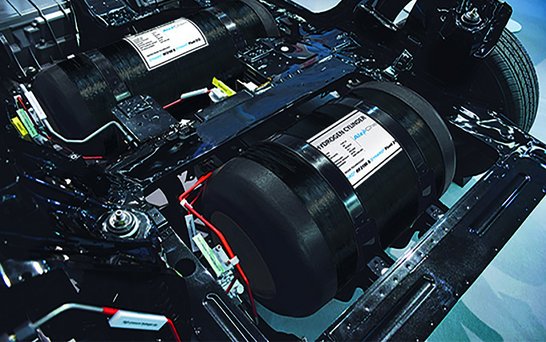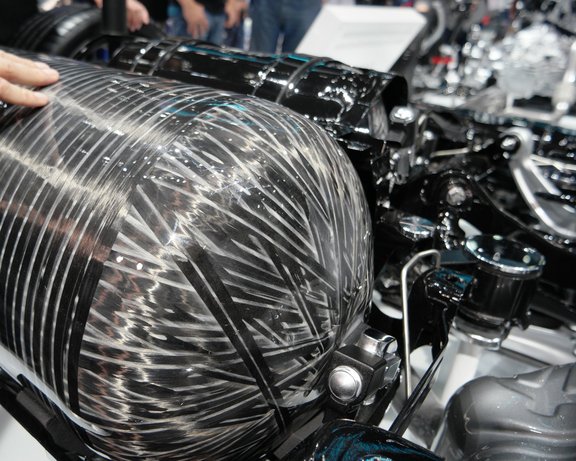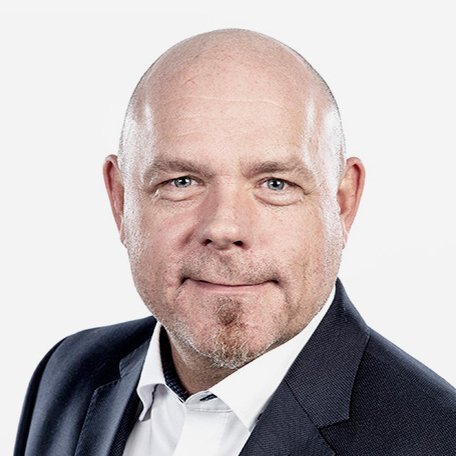“AlzChem goes green”: DYHARD® as a pioneer of an emission-free future
THE MOBILITY OF THE FUTURE IS CLEAN.
The DYHARD® product line, as a future-oriented component of the AlzChem portfolio, comprises a wide range of additives for the production of composite materials in the automotive and aerospace industries, among other industries. Innovation is the program with DYHARD®. Close to the international market and the global trends of the automotive industry, the AlzChem Group offers a complete system from the DYHARD® SYS product line that is specially designed to meet the changing requirements of automotive manufacturers. Our DYHARD® system, consisting of DYHARD® RF2100 – a modified epoxy resin formulation (A-component) – and DYHARD® Fluid 212 – a formulated, latent hardener (B-component) – is specifically designed for the production of wound carbon fiber reinforced type IV pressure cylinders. “Latent” in this context stands for “quiescent reaction behavior.” The more latent the system, the longer the actual reaction, i.e. curing, can be actively delayed, thus maximizing the processing time in the manufacturing process.
These type IV cylinders serve as a tank for storing the gaseous hydrogen for fuel cells in drive technology. This product is characterized by optimized processing properties and reduces cleaning time as well as resin waste and the use of solvents and cleaning agents within the scope of the company goal “Green AlzChem.” AlzChem thus makes a significant contribution to the conservation of resources and supports the change towards emission-free transportation as a factor influencing the global greenhouse effect.
THE DYHARD® FLUID SYSTEM FOR FILAMENT WINDING
Fibers are wetted or impregnated in an impregnation bath in a continuous process and wound as hollow bodies on an inliner to form a cylinder. The resulting high-quality thermosetting plastics with excellent mechanical properties are particularly well suited for the filament winding process. This requires a resin formulation with medium viscosity (viscous fluid), long pot life (processing time of reactive resin masses) at room temperature of 23 ºC and a relatively fast curing speed. Production downtimes caused by cleaning steps due to limited processing times pose a disadvantage for the economic efficiency of the manufacturing processes currently in use. The DYHARD® system, consisting of a low-viscosity epoxy resin component and a formulated latent liquid hardener, improves the impregnation of the fibers and offers an ideal solution.
Our DYHARD® technology is based on a heated impregnation bath with constant viscosity. These are optimal conditions because constant viscosity means constant wetting and impregnation of the fibers. The DYHARD® Complete System for Filament Winding is known for its long pot life (long processability) of several days at slightly higher temperatures (more than four days at 40 ºC). No reaction heat is generated in the process either. This enables a fully continuous process, independent of the outside temperature (summer-winter theme). Fluctuations at various production sites can thus be ruled out worldwide. Controlled processing conditions are an essential factor for global quality assurance for automotive manufacturers (OEMs, Original Equipment Manufacturers) and we meet these high demands.
Fast curing at 120 ºC in combination with particularly long latency time is yet another advantage of our complete system. Low exothermia (heat energy released during a chemical reaction) of the thermodynamic system, optical clarity and high transparency characterize the DYHARD® system for fiber winding applications compared to the amine and anhydride system. Long latency in the impregnation bath and reduced cleaning effort optimize the service life of the production process. More efficient fiber winding with the DYHARD® Fluid System increases production output and thus reduces the costs of composite cylinders. Ideal properties for series production of H2 cylinders.
ON THE TEST BENCH: H2 CYLINDER FOR FUEL CELL VEHICLES
The complete system has already been subjected to various tests in close cooperation with the H2 cylinder manufacturers, i.e. the users of the DYHARD® system for fiber winding. The results are consistently positive and meet the high demands placed on wound hydrogen cylinders for fuel cell technology. Beside the benefits already mentioned, several practical tests confirm further advantages of our resin system for fiber winding. The tests were carried out on a type IV H2 cylinder with a volume of 52 liters and filling pressure of 700 bar and yielded the following results:
- Excellent mechanical properties, toughness and very good pressure cycle testing
- Reduced downtime in production and thus up to 15% higher productivity.
- Possibility of quality control of the resin system in advance
- Very good surface quality due to low shrinkage (volume change of the material)
- Excellent adhesion to carbon fibers
These characteristics of our DYHARD® Fluid System, which are very important for the automotive industry, help us to achieve our ambitious goals.
“GREEN DEAL”: CO2-NEUTRAL EUROPE
Growing urbanity and globalization increase the volume of traffic. Clean air through sustainable transport improves our quality of life. The European Union is committed to reducing CO2 emissions by 30%. The goal of reducing the emission of greenhouse gases is reflected in a high demand for the appropriate technologies. Ambitious fleet targets in heavy-duty transport intensify the development pressure on car manufacturers. The solution is already there: Hydrogen propulsion is considered a quantum leap in the automotive industry. Roadworthy prototypes are being tested. Having already established itself, DYHARD® works closely with OEMs in markets where technology is at the forefront.
THE BEGINNING OF A NEW ERA: FUEL CELL TECHNOLOGY WITH “GREEN” HYDROGEN
Hydrogen production must be cost-effective for a drive that is suited for mass production. Climate neutrality combined with ecological benefits are almost incompatible criteria. High requirements lead to the complex and energy-intensive production of hydrogen: The fuel cell is the core of the hydrogen drive. Electrical energy is generated in the cell by means of chemical conversion of water and oxygen, which drives an electric motor. The splitting of water (H2O) into its components, hydrogen and oxygen, is called electrolysis, an extremely energy-intensive process. Emission-free and therefore “green” hydrogen is therefore based on renewable energies such as wind power or solar energy. Cooling hydrogen to minus 254 °C or storing it at 800 bar pressure is also necessary to achieve sufficient energy density. The tire pressure in a car is around 3.5 bar by comparison. This shows what incredibly high pressures the cylinders must withstand. The issue of safety and continuity in the manufacturing process becomes all the more important, so that each individual cylinder can withstand the pressure. This is where the high quality of H2 cylinders produced with our DYHARD® Fluid System comes into play. The complete system from AlzChem guarantees maximum pressure load resistance for a 700-bar type IV cylinder. Safety first – especially in the automotive sector.
FUEL CELL COMMERCIAL VEHICLES FOR LONG-DISTANCE TRAFFIC IN SERIES
The need for transport is growing and at the same time transport needs to be CO2-neutral. Fuel cell technology represents the ideal solution especially for commercial vehicles with long ranges: On the one hand due to weight reduction, on the other hand due to the environmentally friendly drive technology. What is unusual is that the tanks store the hydrogen at a pressure of 700 bar. Therefore, the tank that can be reliably wound with the DYHARD® Fluid System needs to be quite large. The AlzChem system is suited for different carbon fibers and is therefore a flexible solution for manufacturers.
DYHARD® GOES GLOBAL
Trucks with fuel cell drives are already market-ready, especially in Japan and South Korea. An extended product range for the market entrance in Europe is to follow. The goal of a German car company: To sell exclusively emission-free commercial vehicles in Japan, North America, Mexico and Europe by the end of the decade. DYHARD® has its “ear to the market” and is already in close contact with European and Asian manufacturers. We support the users on all technical matters during the test phase of our DYHARD® Fluid System in order to integrate the AlzChem technology at the manufacturer right from the beginning of the development. The advantages of the DYHARD® Complete System for Filament Winding are being discussed everywhere, whether at trade fairs and conferences, in direct customer contact or through cooperation with universities. AlzChem can rely on its many years of expertise and high product quality MADE IN GERMANY.
E-mobility needs to become affordable and thus attractive for the mass market. The reduction of development costs and accelerated market introduction is central to this cause. Completely continuous production processes in all steps represent the prerequisites for this – and our DYHARD® Fluid System makes this possible.
FUEL CELL DRIVES ON WATER, LAND AND IN THE AIR
Fuel cells are considered efficient energy sources beyond road traffic as well – in shipping, for example: Around 90 percent of world trade is carried out by sea. Together, 90,000 ships emit around one billion tons of carbon dioxide. This makes shipping one of the largest emitters of carbon dioxide among all modes of transport, alongside road and air traffic. The goal is to make transport by sea emission-free with the help of state subsidies. Scandinavia, along with Germany and an American-British cooperation, is a pioneer in the maritime segment when it comes to hydrogen. Next year, the line service of the Hurtigruten will be supplemented by fuel cells. This is due to a new law passed by the Norwegian parliament, which provides for a zero-emission zone along the west coast of the country by 2026. DYHARD® is already in talks with a Finnish manufacturer of fuel cells in the maritime segment. Successful material tests confirm our results. We are on the right track. The German rail network covers nearly 40,000 kilometers, on which the world’s first H2 trains already commute. Diesel locomotives are increasingly being replaced by emission-free trains.
Around 7,000 hydrogen-powered cars were sold worldwide in 2019. Demand is growing, particularly in South Korea, the US and Japan. The DYHARD® Fluid System has already been presented to South Korean and Japanese manufacturers. Further tests are currently underway. Analysts expect up to 15 million hydrogen-powered cars worldwide by 2030.
Aviation consumes 300 million tons of kerosene per year. This results in emissions of over 900 million tons of CO2. A change towards an emission-free drive system is also becoming apparent here. Experts date the fuel cell technology in the short and middle-distance range for large passenger aircraft for aviation to 2050.
THE COURSE HAS BEEN SET
When does an environmentally friendly drive technology like the fuel cell replace conventional mobility? The answer to it is a matter of price: The energy turnaround in traffic depends on it, starting from which time a form of the mobility becomes more economical compared to an alternative. Technological progress is the deciding factor here.
The DYHARD® Complete System for Filament Winding from AlzChem supports the automotive industry’s move towards hydrogen fuel cell technology. We are thus accelerating the development of innovative, climate-neutral mobility MADE IN GERMANY. The course is set for a sustainable future. DYHARD® every day, everywhere – also in the future.


